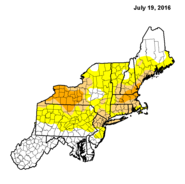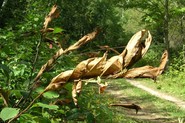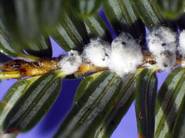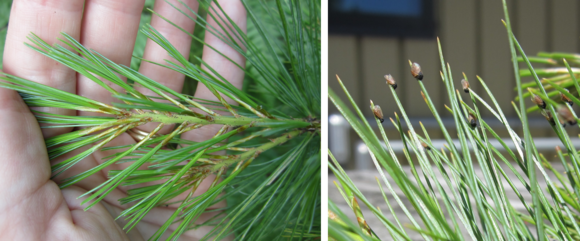Insect & Disease Conditions Update
A printer-friendly version of this report is available on-line from the Conditions Report Index.
 The 2016
growing season has been dry to date. According to the July 19th summary
from the National Drought Monitor parts of the northeast including Maine are in
a short-term drought. Severe Drought conditions exist approximately south of
the boundary created by routes 111 and 202 in southern York County (bordered on
the north by the towns of Saco, Alfred, Sanford and Lebanon). Moderate Drought conditions are found in portions
of Androscoggin, Cumberland, Franklin, Kennebec, Knox, Lincoln, Oxford,
Sagadahoc and York Counties. Abnormally Dry
conditions are found in portions of Androscoggin, Cumberland, Franklin, Hancock,
Kennebec, Knox, Oxford, Penobscot, Piscataquis, Somerset, Waldo, Washington
& York Counties.
Photo: Abnormally
Dry (yellow), Moderate Drought (Tan) and Severe Drought Conditions (orange) in the
Northeast for the Week of July 19, 2016 (Image: U.S. Drought Monitor)
Dry conditions are
stressful to trees—and can be especially hard on smaller trees, those that have
been recently transplanted, and those that are experiencing other significant
stresses. It is important to consider
this stress when pondering management in affected areas and when caring for
ornamental trees. For example, balsam
woolly adelgid infestation of balsam fir can make the host less tolerant of dry
conditions due to changes the insect’s feeding causes in the cells the trees
produces at and around the feeding site. Likewise, defoliation can make a tree
less tolerant of the added stress of dry conditions. To promote health, important ornamental trees
should be watered during dry periods that take place within the growing season.
Additionally the dry spring weather favors early season defoliators as they are
less likely to be controlled by fungal diseases.
On the other hand, the
scarcity of precipitation this growing season could spell some relief from
needle and shoot diseases that have been so prevalent in recent years. However, that is not guaranteed as timing of
moisture, spore production and tissue vulnerability may come together and allow
adequate infection support continued epidemics.
|
We are happy to
welcome Aaron Bergdahl to our team. Aaron joined the Maine Forest Service as a forest pathologist on July
20th. He comes to Maine from the North
Dakota Forest Service, where he was the forest health manager for seven
years. Before that he completed a
master’s degree in Finland where he lived and worked for 10 years. Originally from Vermont, and a graduate of
the University of Vermont forestry program, he is very pleased to be back in
the northeast and especially glad to be in Maine. Aaron’s interests include many outdoor
activities such as gardening, growing fruit trees and shrubs, mushroom hunting
and fishing. He has a wife and three
children and plans to settle in the Augusta area in the near future. Aaron is
looking forward to serving Maine residents by providing technical assistance
and educational opportunities, while building relationships with partners and
stakeholders to maximize opportunities to address forest and tree health issues
statewide. One of his first projects he
plans to focus on is the white pine needle damage situation. You can reach Aaron at the lab at (207)
287-3008 or aaron.bergdahl@maine.gov.
Additionally, we are pleased to announce that Joe
Bither of Stockholm, ME has accepted the position of Senior Entomology
Technician, which was vacated when Mike Skinner retired in December 2014.
Joe brings a broad forestry background and experience in insect survey to this
position. He has been a Maine Licensed
Professional Forester since 2003 and completed his BS in Forest Management at
the University of Maine in 1993. Joe has
been with the Forest Inventory and Analysis (FIA) unit of Forest Health and
Monitoring since 1999 and in recent years has helped out with surveys for
emerald ash borer, gypsy moth (trapping and egg mass scouting), spruce budworm
(adult and overwintering larvae surveys) and pine shoot beetle. This year he has been busy tending to 40
beetle traps in Aroostook County as well as trap routes for spruce budworm and
gypsy moth, all the while continuing his work with FIA. Joe will split his time between FIA and insect
and disease management in his current assignment.
A combined summary of 2014 and 2015 activities
is now available on-line and in print. You will find the online version on our
website at: http://maine.gov/dacf/mfs/publications/condition_reports.html. Subscribers who have signed up for a print
copy of the report should receive them very soon if they haven’t already. Others may contact the lab to request a print
version of the document.

This request
came in just before we were ready to hit send and print labels for this
bulletin. Please contact Emily with
questions or requests for more information. This request pertains to our
readers in the shaded area shown in the accompanying map.
Are you
seeing large amounts of moths around your porch or street light? They might be
spruce budworm…and we want them!
Over the
past few days there have been numerous reports of moth swarms throughout
Atlantic Canada. Weather radar imagery indicates that these are very likely
immigrants coming on wind currents. That being said, we still don’t know much
about these moths: Are there many female moths (with eggs) migrating or are
they mainly males? Are the females that
migrate carrying many eggs or have they already unloaded them? We are calling
on people like you to help us answer these questions, and in doing so helping
us to better understand how spruce budworm outbreaks spread.
Here is what we are asking: Six simple
steps.
- Look for moths (live or dead) beneath
your porch or street light. They may be on the ground or wall.
- Sweep these moths into a paper
or plastic bag.
- Add a piece of paper that has
your name, address (of collection), and the date.
- Put the bag into your freezer
(this is important to preserve the eggs for counting).
- Repeat as often as you can for
the next three weeks – check once per day or a couple times per week, whatever
works for you!
- Contact us to tell us who you
are and we’ll contact your to arrange pickup of moths. Contact Emily Owens
(Budworm Tracker Coordinator) via e-mail (emily.owens@canada.ca),
on Twitter (@emilyowenz), on Facebook (https://www.facebook.com/budwormtracker/?fref=ts)
or through the Healthy Forest Partnership Website (http://budwormtracker.ca/#/).
As
a side bonus, for all who participate, we will be adding your name to a draw to
win one of 5 fancy “Budworm Tracker” T-shirts and will add you to the e-mail
list (if you so desire) for occasional updates on the ongoing spruce budworm
outbreak.
|
Bare-Patched Oak Leafroller (Pseudexentera
spoliana (cressoniana)) – Defoliation from this pest has
subsided in the Augusta area. However,
it has continued in the Cherryfield portion of Washington County and adjacent
Hancock county. A few thousand acres have moderate to severe defoliation this
year and there is now some mortailty in the oaks in this area.
 Browntail
Moth (Euproctis chrysorrhoea) – This spring was the worst one for
browntail moth caterpillars in over a decade. Extremely high numbers of larvae
stripped the leaves before they had hardly begun to unfurl and then the larvae
dropped to the ground and spread out devouring the leaves of trees and shrubs
they encountered. From Woolwich to Freeport and inland to Bowdoinham they
defoliated the oaks and spot infestations along the coast and in as far as
Turner were reported. The heaviest hit area was Bowdoinham and Topsham. Parts
of these two town may get some relief next year as a few days of cool, damp
weather in June allowed the fungus Entomophaga
miamaga to take hold causing a small epizootic and killing thousands of larvae.
Dead larvae were literally falling out of the trees and people in those areas
are reporting fewer moths.
Licensed pesticide applicators were out straight
trying to treat all the properties where people requested control of the larvae
and the town of Cumberland did a ground treatment along route 88 using Conserve
(active ingredient spinosad). The lab has logged close to 200 calls/emails
concerning browntail. Numerous news stories covered the epidemic and hundreds
of people sought relief from the rash with visits to doctors, clinics and
pharmacies.
Photos: Browntail Moths (Euproctis chrysorrhoea) in Augusta
July 12 (Photo: Maine Forest Service)
The
Maine Forest Service and Dr. Ellie Groden of the University of Maine, collected
hundreds of browntail cadavers and cocoons and the University is holding the
fungus-infused cadavers for possible control work in the future. They are also
looking at possible transfer of the fungus to the adult moths.
The trees have refoliated
and most will survive this round. Browntail moths are good mothers and tend to lay their eggs
on the leaves of trees that have not been stripped and then refoliated (this
second round of foliage is not as good quality – a way of the trees protecting
themselves from more feeding). But there are plenty of other trees out there to
support the population.
Browntail adults are
finishing flying and we are getting reports of huge numbers in the core area
around Bath/Brunswick plus moths from Skowhegan to Saco. Department Facebook
posts July 15th about the moths drew thousands of viewers. Next year
is going to another bad one and the infestation will most likely be larger.
|

Cherry Scallop Shell Moth (Hydria
prunivorata) – This is a very occasional pest of cherry trees - so
occasional that our senior entomologist has not seen an outbreak in her 22
years with the Maine Forest Service. There is a small patch of defolation from
this leaf tying caterpillar in the Turner (Androscoggin County) where there is
a stand of cherry trees. These larvae carefully fold one or more cherry leaves
over and stich them together. They then feed inside this protected enclosure
carefully skeletonizing the leaves but leaving the outer layer whole. The
leaves are all brown but stay on the tree most of the summer. The larvae are
finishing their feeding now.
Photo: Cherry Scallop Shell Moth Webs (Hydria prunivorata) (Photo: Maine Forest Service)
|

Emerald Ash Borer (Agrilus planipennis) – Emerald ash borer (EAB) has not yet
been found in the state of Maine. Purple
traps have been hung throughout the state.
Unlike in previous years, the federal government has contracted with a
private company to hang and service the traps.
Although the Maine Forest Service is not involved with this aspect of
detection this year, we continue to actively survey for signs of damage and
encourage public reporting of suspect trees.
Photo: Cerceris fumipennis with emerald ash borer (Photo: Philip Careless, Ontario)
Biosurveillance for EAB has started for the 2016 season, www.maine.gov/cerceris. Again, no EAB have been found
so far. If you find any colonies of
wasps (often found on baseball diamonds) you think may be Cerceris fumipennis, please contact us and we will check them
out. We are always on the lookout for
new colonies of this wasp to help us monitor for EAB.
Given the current known distribution of EAB relative
to Maine’s borders it is too early to be using pesticides to treat for the pest
anywhere in the state. That doesn’t mean
it is too early to read up on the methods one might use to treat ash
trees. The insecticide guideline from
the North Central IPM Center is available on-line: http://www.emeraldashborer.info/files/EAB%20Bulletin%202014-final.pdf.
|
 Elongate Hemlock Scale (Fiorinia
externa) – Elongate hemlock
scale (EHS) has recently been discovered on Frye Island. Until now, EHS was known to be established in
native forest trees only in one area of southern Kittery. All other infested trees we have found in the
state had been brought into the state in an infested condition. We have treated these trees aggressively to try
to prevent or slow spread from that tree into the surrounding forest.
Elongate hemlock scale on hemlock (photo: Maine Department of Agriculture Conservation & Forestry)
Although we have so far
only found EHS in one location on the island, it has quite possibly become
established in other areas, since we found it on a tree which would have
brushed against Fire and Rescue trucks every time they went out on a call. This would have transported crawlers every
time the trucks went out. We will
continue to look for EHS on the island.
The town of Frye Island has been very proactive in dealing with this
insect and trying to contain it. They
pruned back the affected tree immediately to stop further spread and are
working with the Maine Forest Service to educate the people of the town and to
reduce further spread.
Remember that at this time of year, tiny crawlers are present, and it
is very easy to transport EHS on clothing, machinery and vehicles.
|
Forest
Tent Caterpillar (Malacosoma disstria) – Defoliation by forest tent caterpillar has not detected in
Maine. This is notable partly because it
was found by our neighbors in New Hampshire and Vermont at levels detectable in
aerial survey. This continues to be a
pest worth watching.
Gypsy
Moth (Lymantria dispar) – Gypsy moth in
southern Maine have begun pupation—and some have completed their life
cycles! A male gypsy moth was seen in
Cherryfield (Washington County) on July 15th and a second one in T10
SD (Hancock County) on the same day. Maine
Forest Service deployed 400 traps for this moth in parts of Maine not yet
quarantined for the pest. Last week Joe
Bither hung the last of our traps in north-western Aroostook County.

Hemlock Woolly Adelgid (Adelges tsugae) – Hemlock woolly adelgid (HWA) was
recently found on Frye Island in Cumberland County, thanks to a tip from a
local arborist. HWA has probably been
present on the north end of the island for several years where some hemlock
trees are in very bad shape. Trees in
the southern part of the island are still generally healthy and many do not
have detectable levels of HWA. The town
has been very proactive about dealing with HWA and within hours of learning
about it had already started pruning hemlock trees back from parking areas
around the public works depot, brush dump, and other high-risk areas. They have been working with the MFS to
educate their citizens and are doing all they can to slow down the spread of
this insect. HWA has also been found in
the adjacent town of Raymond. We will
continue to survey for HWA in the towns of this area.
Photo: Hemlock woolly adelgid covered in ‘wool’ and juveniles to the left (Photo: USFS)
If you are harvesting hemlock you are encouraged to examine branches
of felled trees for signs of HWA and elongate hemlock scale (EHS). They are both more readily detectable from
canopy samples than from the ground. If
you have any doubt whether what you are looking at is HWA (or EHS), bag a
sample and put it in the mail to the lab.
Often all that is required to ship it is a standard-sized envelope and a
single stamp.
We are nearing the time when most crawlers will be settled on the new
growth of hemlock. August first is when
we generally think of as being low risk of spreading HWA on anything but rooted
trees. Given the nature of insects, the
actual date varies from year to year.
August through February is the best time to work in hemlocks from the standpoint
of minimizing the risk of introducing or spreading HWA.
|
Oak Twig Pruner (Anelaphus parallelus) – Calls
and e-mails have started to come in about oak twig pruner damage. So far reports have come in from Durham
(Androscoggin County), Edgecomb and Waldoboro (Lincoln County), Otisfield and
Peru (Oxford County), Dixmont and Old Town (Penobscot County) and Richmond
(Sagadahoc County). This species takes two years to mature. In their second season of feeding the larvae
make pruning cuts beneath the bark. They cut around the branch except for the
thin bark so that the branches break with the wind and fall to the ground.
Sometimes the branches are noted when they are dangling in the crown—a spray of
reddened, withered leaves. Others,
people notice the fallen twigs and note the fine workmanship of the cut (and
sometimes even note the frass or the larva itself). The larvae pupate within the twig in the
fall. Many winters they are insulated by a warm blanket of snow. Oak twig pruner is not a significant threat
to tree health.
 Pine Leaf Adelgid (Adelges pinifoliae) – As was guessed in the May report, this was a
year of abundant galls in red and black spruce caused by the pine leaf
adelgid.
Galls were open and females flying and depositing eggs on pine needles
in T6 R13 WELS (Piscataquis County) on June 15th. This seemed to be near peak of adult
emergence at this site in 2016. Many had
hatched from the eggs under females on pine needles and settled on 2016
twig-growth by July 7th in T4 R7 WELS (Penobscot). It was observed
that most galls had fallen from affected spruce during a visit to T6 R13 WELS
site on July 14th. Those
remaining on the tree were only lightly attached to the twigs. Fewer galls had fallen and those still
attached were firmly connected to the twigs at a second site visited the same
day in T5 R11 WELS (Piscataquis County). If an observer wanted to rate the level of
galling in the spruce host, it would be best done in mid- to late- June in this
area of north-central Maine.
Photos: Above: Cone-like
galls on spruce caused by pine leaf adelgid.
Note recently opened gall in lower right and older, dried galls in upper
left. Unlike some other adelgid galls, these
are deciduous. Below Left: Eggs hatch and nymphs settle on the
current-year twigs of white pines (black specks, Photo July 14). Below Right: Adult females, having emerged from galls on spruce settle on white pine needles (Photo June 22). Abdomen splits and eggs remain protected under the roof of the adult wings.(Photos: Maine
Forest Service)
|
 Elevated activity of this pest was first reported in September 2012. This was likely early damage caused by nymphs
that had settled that same year. We did
not have many reports of damage to pine in 2013; however, in 2015 people who
visit the North Maine Woods were noticing and reporting damage to the
gates. Also in 2015, aerial survey
efforts mapped almost a quarter million acres damaged by this pest. We can expect another year with significant
flagging of outer branches in white pine next year. Some of that damage may show up as early as
late-summer 2016, but we expect more to be expressed by spring 2017. Affected pine will experience growth impacts
and casual surveys have shown there is already some tree mortality
apparent. The last recorded outbreak of
this pest in Maine lasted approximately 10 years.
Winter
Moth (Operophtera brumata) – Winter moth was
not as severe a problem this season as was expected. Most areas had moderate
defoliation although some new parts of Harpswell were harder hit but no trees
completely striped in that town. The apparent reason for this was delayed
foliage due to weather and, in some cases, severe damage from past years
defoliation, caused morality of newly emerged larvae. Unfortunately for some
trees in Cape Elizabeth this reprieve came too late and there is now tree
mortality in that town.
No parasitic flies were released in Maine this
year as there were none available. Hopefully next year there will be a large
enough population of Cyzenis albicans
flies from Massachusetts that we can release more in Maine. The very good news
is that the flies have become established in at least Kittery after just two
years. The report is not back yet on the
other release towns.
Reminder: DO NOT MOVE soil, perennials,
saplings etc. from under or near
winter moth infested trees. You will be moving winter moth with the soil/plant
material. The cocoons look like dirt.
Herbicide injury – Herbicide injury, from right
of way management, has been noted by some who have recently travelled the
golden road. Leaves in aspen crowns
along the road west of Millinocket are stunted and distorted; white pine mortality
is also particularly striking. Damage to
the white pine adds to the apparent impact of pine leaf adelgid. This type of injury is not restricted to
private woods roads as similar methods are used in right of way maintenance on
public roads. It is important for many
reasons to get away from the road before drawing conclusions regarding the
health of the forest beyond.
White Pine Needle
Diseases – White
pine needle damage was again a major concern of clients in Maine this June and
July. Most reports came in from Kennebec
County and south (including the towns of Augusta, Belgrade, Berwick, Casco,
Gray, Kittery, Oakland, Porter, Saco, South Berwick, West Gardiner and
Windham), with a single public report from Dover-Foxcroft (Piscataquis
County). In addition to calls from the
public, damage was observed by division staff along Route 2 from the New
Hampshire border east to Bangor; in the area along Routes 15 and 43 between
Dover-Foxcroft to Old Town; as well as in northern York County.
August
2nd, 7-8 pm, Thomas Memorial Library, ME. Combatting Winter Moths,
in Partnership with the Cape Elizabeth Garden Club. Charlene Donahue,
entomologist with the Maine Forest Service will discuss last year’s Winter Moth
infestation and discuss how you can combat the negative effects of this
infestation on your trees and gardens both this season and next.
August 13th, Hardwood
Silviculture, Newall Tree Farm, Unity/Thorndike, ME. This joint NESAF/SWOAM field tour will focus on
hardwood silviculture including discussions of forest soils & site
productivity, silviculture and management of beech bark disease, crop tree
management and aspen/poplar management. This
will be an opportunity to meet our new pathologist, Aaron Bergdahl. Registration required, www.mesaf.org, field tours.
August 13th, Forest
Heritage Days, Greenville, ME.
We will have a display table at Forest Heritage Days in Greenville on Saturday
August 13th. Stop in and see
us if you’re at the event. We’ll be set
up from 10 to 3 in the gymnasium. You
can learn more about Forest Heritage Days here: http://www.forestheritagedays.org/.
August
24th & 25th, Maine Farm Days 2016, Misty Meadows Farm,
Clinton, ME. The event includes activities for both farmers and non-farmers alike. There
are a range of agribusiness exhibits’, equipment dealers, wagon tours,
children’s learning center, craft tent, farmers market and educational speakers
and presentations. Charlene Donahue will speak on ‘Invasive Forest Pests -
Slowing the Spread’. http://kcswcd.org/?page_id=176.
September 10th, Maine Tree
Farm/SWOAM Forestry Field Day, Pine Tree Camp, Rome, ME. The Field Day includes woods tours covering locating
and constructing roads and trails, best management practices to protect water
quality, managing deer wintering areas and stands of older trees, rebuilding
camper’s cabins and pest problems. There will be vendors and educational
stations by a variety of organizations and agencies. For more information
contact Gretchen Heldmann, coordinator@mainetreefarm.org, the Maine
Tree Farm Coordinator or SWOAM, info@swoam.org.
September 13th, 9am – 3pm,
State Museum, Augusta, ME. BUG MAINE-IA. Creepy, crawly as Bug Maine-ia
invades the Maine State Museum. A great learning experience for kids and adults
as bugs from Maine and around the world (many living) converge under one roof!
Admission is FREE. http://mainestatemuseum.org/.
September 14th, 6-7 pm,
Freeport Community Library - Freeport, ME. Browntail Moth Informational
Session. Charlene Donahue will
discuss the browntail moth problem.
Sept 23-25, Common Ground Fair: MFS
will have two displays at Common Ground Fair.
There will be a display on emerald ash borer with respect to brown ash
and basket-making in the Native Arts tent in the Maine Indian Basketmakers
area. Please also visit the MFS booth
just outside the Pine (south) Gate.
|